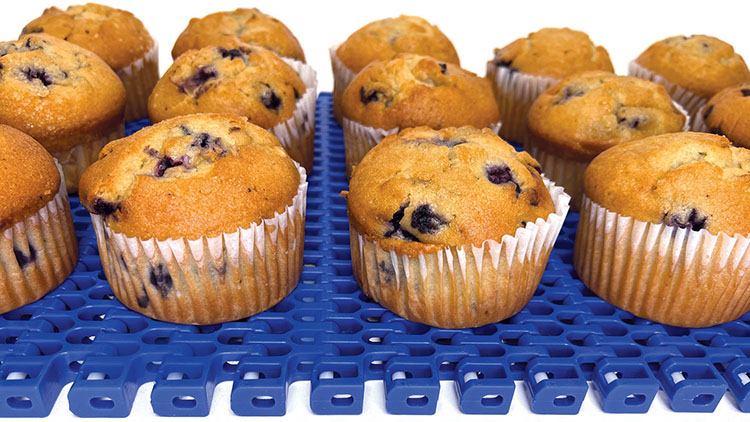
Plastic conveyor belts bring unique characteristics to the table – they are light, hygienic and easy to fix.
In bakeries, plastic belt systems can be configured for several operations, as they provide a great solution to driving the products through processing steps.
Just like their metal counterparts, plastic belts can be customized to meet specific requirements for several processes in a bakery, including cooling, proofing, and freezer applications. They can be successfully used for smaller products, too, and can perform tight transfers. Why plastic? “Plastic offers release properties that metal may not allow. Plastic belts can also run quieter and can often be repaired quicker and with simpler tools than metal belts,” explains Jonathan Lasecki, Ashworth’s Director of Engineering. Their smooth surface lends it to minimal product sticking, as does the reduced contact area.
”Plastic offers release properties that metal may not allow. Plastic belts can also run quieter and can often be repaired quicker and with simpler tools than metal belts.“
WJonathan Lasecki, Director of Engineering, Ashworth
Ashworth’s plastic belts, for example, are tested for over 100,000 fatigue cycles, under all the conditions needed for cooling, proofing and freezing in a bakery. They are designed for use in spiral systems predominantly, but can also be used in other conveyor segments. Possible configurations can be flexibly designed: “These belts will operate on both inclining and declining systems and all typical belt paths, straight through, 90-degree, etc. They can also be used on straight running and turn-curve conveyors,” Lasecki details.
Both belt models made by the American specialist, SpiralSurf® 100 and SpiralSurf® 200 (with 1” and 2” pitch – the distance between rods), can be used in bakeries, and are particularly well suited for conveying baked or packaged products. They come in one surface style (as pictured), designed with openings and patterns that can accommodate various products. Plastic belt systems can have multiple uses. But, sticky products such as raw dough should not be placed directly on the belt for freezing, the manufacturer notes, as they have more strict conveying requirements when being conveyed, on any type of surface.
A close-up view: SpiralSurf® belts
Ashworth SpiralSurf® belts are manufactured with either Acetal (POM) or Polypropylene (PP) components. The first option, POM, is suitable for use between -40°C and 93°C (-40°F to +200°F), while PP should be used for processes running at temperatures in the 5°C to 104°C range (+41°F up to +220°F). To customize the belts, plastic or stainless steel rods are available. For products that may move on the belt, guard edges are an optional feature that can be requested. For product sorting, lane dividers are also available.
Assembly is another benefit of plastic belts. Setting up Ashworth’s SpiralSurf® belts is simple and requires no special tools: “Connect the ends and insert a connecting rod to make it continuous. General construction rules used for belt conveyors apply,” Lasecki explains, adding that suitable guarding should be installed for personnel safety. As long as the conveyor is correctly set up, the belt will track and run as intended: “A proper take-up system must be part of the conveyor construction, to allow for variations in belt length due to tension, wear and/or temperature variations,” the specialist observes. The SpiralSurf® 100 has smaller open areas to support smaller products safely, while the SpiralSurf® 200, which has larger open areas, allows for better airflow.
Use and maintenance
While lifespan may vary according to utilization, Ashworth belts are guaranteed to run for well over 100,000 cycles, where a fatigue cycle is a load/unload of tension in the belt. As a general consideration, the operating speed influences the belt’s longevity: a belt running slow will last much longer than a belt running at fast speeds. In general, belts should run at maximum speeds of 30 m/min (100 ft/min); however, some processes require belts to run at considerably higher speeds. In this case, a corresponding shorter lifespan should be expected, as well as more frequent service/maintenance work throughout.
Cleanliness is also critical to extending the plastic belt’s life. “Allowing product debris or fine dust particles to accumulate on the belt will create abrasive wear and lead to belt stretch and/or component failure,” the specialist underlines. Ashworth recommends what to consider to extend their lifespan: “Plastic belting is affected by harsh cleaners, UV light and the lack of or improper monitoring of the belts’ operation. Plastic belts will typically break either at the hinge rods or the belting modules themselves,” he adds.
One of the advantages of plastic belts is that only the damaged section can be replaced, by removing a pin ahead and just after the damaged section, and then adding a new section that matches the previous one in length. The old part is sent off to recycling, while the new part is installed by joining the ends and inserting the necessary connecting pins.
In day-to-day operations, the belt must always remain perfectly aligned and its tension must be uniform across its width. Misalignment of only a few mm can lead to belt damage; uneven tension leads to mistracking and causes the belt to stretch and break over time, causing downtimes unless prevented. Belts should be inspected frequently (relative to the process), to avoid this, Ashworth recommends. “Inspection checklists must be established at each installation, based on the system and process parameters,” Lasecki underlines. System alignment is critical to proper belt operation.
Setting up a production line with plastic spirals (or other suitable conveyors) is not only a choice helping with process efficiency, but also proof that there are still applications where plastic is a great choice.


